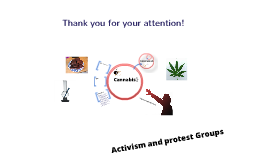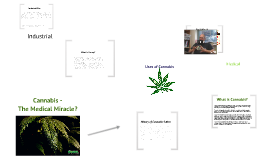Cannabis
Transcript: Cannabis - The Medical Miracle? History of Cannabis Sativa Cannabis sativa is the oldest and most resourceful crop sown. In fact, sativa means 'useful' in Latin. Canvas is derived from "cannabis", the Latin word for "marijuana." Industrial hemp could supply most of mankind's fuel, fiber and food needs and will be the agent of transformation for our economy away from many toxic petrochemical products to nontoxic, agriculturally-based alternatives. Cannabis sativa produces more fuel, fiber and food per land area cultivated than any other plant. Archaeologists agree that cannabis has been purposely cultivated for over 12,000 years and all archeaologists agree it is among the first few crops purposely cultivated by humans, and could well be the first. Cannabis flowers produce a medicine, sacrament and social drug that mimics newly discovered neurotransmiters, or brain chemicals. For over 5000 Years prior to 1842, marijuana and hashish extracts were the most widely-used medicines in the world. Benjamin Franklin started one of America's first paper mills with cannabis, allowing a colonial press free from English control. The U.S. Government distributed 400,000 pounds of cannabis seeds to American farmers in 1942 to aid the war effort What is Cannabis? Cannabis is derived from the cannabis plant (cannabis sativa). It grows in many of the tropical and temperate areas of the world. It can be grown in almost any climate, and is increasingly cultivated by means of indoor hydroponic technology. The main active ingredient in cannabis is called delta-9 tetrahydro-cannabinol, commonly known as THC. This is the part of the plant that gives the "high." There is a wide range of THC potency between cannabis products. Cannabis is used in three main forms: marijuana, hashish and hash oil. Marijuana is made from dried flowers and leaves of the cannabis plant. It is the least potent of all the cannabis products and is usually smoked. Hashish is made from the resin (a secreted gum) of the cannabis plant. It is dried and pressed into small blocks and smoked. It can also be added to food and eaten. Hash oil, the most potent cannabis product, is a thick oil obtained from hashish. It is also smoked. Cannabis is usually smoked in hand-rolled cigarettes (known as "joints") or in special waterpipes ("bongs"). These pipes or bongs can be bought or made from things such as juice containers, soft drink cans or even toilet rolls. Uses of Cannabis Industrial Industrial Use FACT: George Washington grew hemp at Mount Vernon as one of his three primary crops. The use of hemp for rope and fabric was ubiquitous throughout the 18th and 19th centuries in the United States. What is Hemp? Recreational Medical For the simple act of growing cannabis in America, individuals can lose their jobs and their parental rights, have their properties and assets seized and forfeited, and receive enormous bails, fines and prison sentences with no chance of parole. Under the 1988 Anti-Drug Abuse Act, the federal government can impose the death sentence for a marijuana farming enterprise, even if no violent crime has occurred. Elsewhere in the world, countries in Asia, the European Community, and recently Canada legally farm hemp for textiles, plastics, food, beer, paper, oil and other products. Hemp is a distinct variety of the plant species cannabis sativa L. that contains minimal (less than 1%) amounts of tetrahydrocannabinol (THC), the primary psychoactive ingredient in marijuana. It is a tall, slender, fibrous plant similar to flax or kenaf. Various parts of the plant can be utilized in the making of textiles, paper, paints, clothing, plastics, cosmetics, foodstuffs, insulation, animal feed and other products. Hemp produces a much higher yield per acre than do common substitutes such as cotton and requires few pesticides. In addition, hemp has an average growing cycle of only 100 days and leaves the soil virtually weed-free for the next planting. The hemp plant is currently harvested for commercial purposes in over 30 nations, including Canada, Japan and the European Union. Although it grows wild across much of America and presents no public health or safety threat, hemp is nevertheless routinely uprooted and destroyed by law enforcement. Each year, approximately 98% of all the marijuana eliminated by the DEA's "Domestic Cannabis Eradication/Suppression Program" is actually hemp.

















